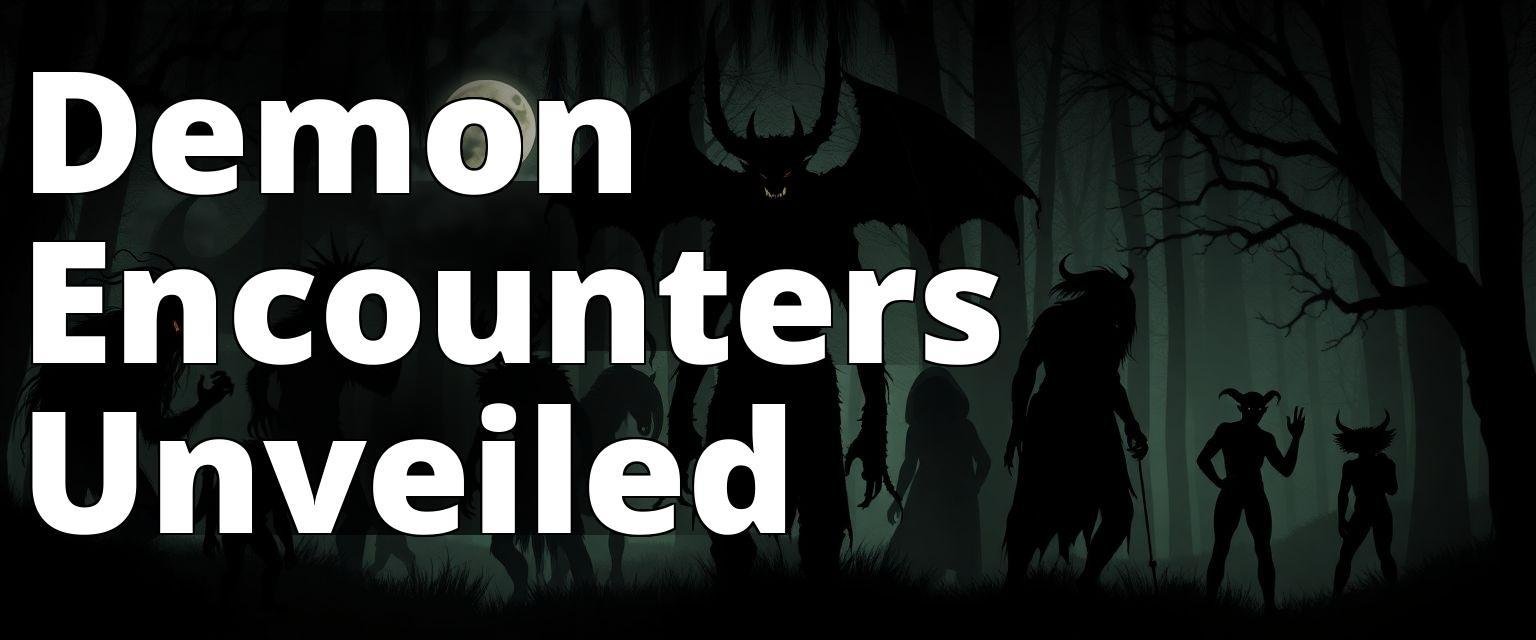10 Terrifying Demon Encounters From Around The World
What if the stories you heard as a child about monsters under your bed or ghosts in your closet were true? Could these tales be more than just figments of our imagination? Across the globe, many cultures have spun legends of demons and sinister spirits that haunt their people. These legends have been passed down through generations, serving as cautionary tales or explanations for the unexplainable. In this article, we will explore ten famous demonic encounters from various parts of the world, each with its own unique backstory and chilling details.
Explore Demonic Folklore
Discover chilling tales of demons from diverse cultures around the globe, showcasing their unique characteristics and encounters.
– Learn about the Churels, a vengeful spirit from South Asia that preys on men, often appearing as a beautiful woman.
– Explore the Aswang, a shape-shifting creature from the Philippines known for its terrifying ability to consume flesh and blood.
– Understand the Jinn, supernatural beings in Arabic folklore that can be both benevolent and malevolent, often influencing human affairs.
1. The Legend Of The Churels
Have you ever heard of a ghostly woman with backward-facing feet? The Churel is a demon from Indian folklore, often depicted as a vengeful spirit of a wronged woman, haunting the very people who caused her suffering. The Churel is said to lure victims with her beauty before revealing her true grotesque form.

Many believe that Churels are the spirits of women who died during childbirth or under tragic circumstances, leading them to seek revenge on the living, particularly targeting men. The Churels story serves as a chilling reminder of the consequences of societal injustices against women. The legend of the Churel not only instills fear but also reflects cultural attitudes towards gender and morality.
Insider Tip: According to Indian folklore experts, leaving shoes upside down outside your door can ward off the Churel. This superstition highlights how deeply these legends are interwoven into cultural practices.
For more on Indian folklore, check out this source on Indian demons.
2. The Legend Of The Aswang
In the Philippines, there exists a terrifying creature known as the Aswang. This shape-shifting demon is notorious for its ability to transform into animals and its insatiable hunger for human flesh, particularly that of unborn children. The Aswang often leads a double life, appearing as a regular human by day and transforming into a fearsome creature by night.

The Aswang legend has been a significant part of Filipino culture, often used as a warning against wandering alone at night. It’s fascinating how the legend of the Aswang reflects societal fears and norms, especially in rural areas where such stories are passed down through oral traditions. The tales of the Aswang have also influenced modern media, appearing in films and literature.
Insider Tip: If you ever visit the Philippines, locals might advise you to carry garlic or salt, as they are believed to repel the Aswang.
For those interested in exploring more about the Aswang, visit this article about Filipino myths.
3. The Legend Of The Jinn
Do you believe in wishes and the spirits that grant them? The Jinn, from Islamic mythology, are supernatural beings that can be both benevolent and malevolent. Unlike the Western depiction of a genie, Jinn are complex creatures capable of great good or evil, depending on their nature.

The origin of Jinn legends can be traced back to pre-Islamic Arabian mythology, where they were considered spirits of nature. In Islamic theology, Jinn are said to be created from smokeless fire, possessing free will like humans. This dual nature of Jinn has led to countless tales of encounters with them, where they can either grant wishes or cause chaos.
Insider Tip: In many Middle Eastern cultures, people recite specific prayers to protect themselves from malevolent Jinn, particularly during travel or at night.
For a more in-depth understanding of Jinn, check out this reference on Jinn in Islamic belief.
4. The Legend Of The Wendigo
Could the cold, harsh wilderness hide a dark secret? In the folklore of the Algonquian tribes in North America, the Wendigo is a malevolent spirit associated with cannibalism, winter, and famine. The Wendigo is said to be a gaunt, emaciated creature driven by an insatiable hunger for human flesh.

The legend of the Wendigo is deeply rooted in the Native American experience with the harsh winters of the northern forests. It serves as a cautionary tale about the dangers of greed and isolation. The Wendigo myth has been popularized in modern horror fiction, drawing attention to the rich storytelling traditions of Indigenous peoples.
Insider Tip: Some Algonquian tribes believe that merely speaking of the Wendigo can summon its presence. This belief underscores the power of oral tradition and the fear associated with this creature.
For more on Native American legends, explore this source on Indigenous mythology.
5. The Legend Of The Chupacabra
What creature could leave a path of dead livestock in its wake? The Chupacabra, also known as the “goat-sucker,” is a legendary creature in Latin American folklore, feared for its blood-sucking habits. Descriptions of the Chupacabra vary, but it is often depicted as a reptilian creature with spikes along its back.

Reports of Chupacabra sightings began in Puerto Rico in the 1990s, spreading to other parts of the Americas. The legend of the Chupacabra reflects anxieties about unexplained livestock deaths, often blamed on this elusive creature. The mystery surrounding the Chupacabra continues to capture the imagination of cryptid enthusiasts and folklorists alike.
Insider Tip: Some researchers suggest that sightings of the Chupacabra might be linked to coyotes with mange, a theory that attempts to rationalize the folklore with scientific explanations.
For more insights into the Chupacabra legend, visit this analysis of cryptid sightings.
6. The Legend Of The Duppy
Have you ever felt a chill run down your spine at night? In Caribbean folklore, the Duppy is a restless spirit known to haunt the living, often associated with mischief and malevolence. Duppies are believed to be souls of the dead who have not found peace.

The concept of Duppies is prevalent in Jamaican culture, where they are often blamed for unexplained phenomena and bad luck. These spirits are said to dwell in cotton trees and other secluded areas, emerging at night to cause mischief. The belief in Duppies highlights the Caribbean’s rich spiritual traditions and the fusion of African, European, and Indigenous influences.
Insider Tip: To protect oneself from a Duppy, some Caribbean cultures suggest placing grains of rice or salt at doorways, as Duppies are believed to be compelled to count them.
For further reading on Caribbean folklore, check out this resource on Duppy legends.
7. The Legend Of The La Llorona
What would drive a mother to wander the earth in perpetual sorrow? The legend of La Llorona, or “The Weeping Woman,” is a tale from Mexican folklore about a ghostly figure who mourns her drowned children. La Llorona is often depicted as a woman in a white dress, crying near bodies of water.

The story of La Llorona serves as a warning to children to stay away from dangerous waters. This legend is deeply ingrained in Mexican culture, often recounted during family gatherings and cultural events. The tale of La Llorona has also crossed borders, becoming a popular subject in films and literature.
Insider Tip: In some versions of the tale, La Llorona is said to abduct children who resemble her lost offspring, adding an extra layer of fear to her story.
For a deeper dive into the legend of La Llorona, explore this article on Mexican folklore.
8. The Legend Of The Yara-ma-yha-who
Could a tree hide a lurking predator? In Australian Aboriginal folklore, the Yara-ma-yha-who is a small, vampire-like creature that dwells in fig trees, preying on unsuspecting travelers. This creature is characterized by its red skin and large mouth, lacking teeth.

The Yara-ma-yha-who legend serves as a cautionary tale, warning against wandering alone in the bush. Unlike traditional vampires, this creature doesn’t drain blood but rather swallows its victims whole, regurgitating them alive. This unique twist on the vampire myth showcases the rich diversity of Aboriginal storytelling and its emphasis on the natural world.
Insider Tip: To avoid an encounter with the Yara-ma-yha-who, Aboriginal legends suggest sticking to well-trodden paths and avoiding solitary fig trees.
For more about Australian Aboriginal mythology, check out this resource on indigenous tales.
9. The Legend Of The Tikbalang
Have you ever thought about what might be lurking in the forests of the Philippines? The Tikbalang is a creature from Filipino folklore, often described as a half-human, half-horse monster. Known for misleading travelers, the Tikbalang is said to create illusions to confuse and lead them astray.

The Tikbalang legend is a staple in Filipino rural culture, symbolizing the fear of the unknown and the danger of venturing into uncharted territories. These creatures are believed to guard the forests, punishing those who disrespect nature. The Tikbalang is a fascinating blend of local superstition and cultural values, emphasizing respect for the environment.
Insider Tip: To ward off the Tikbalang, some Filipinos suggest wearing your shirt inside-out or reciting specific prayers to break its illusions.
For an exploration of Tikbalang myths, visit this article on Filipino folklore.
10. The Legend Of The Preta
What happens to souls consumed by insatiable desire? In Buddhist and Hindu mythology, the Preta is a ghostly figure tormented by unending hunger and thirst, often depicted as a skeletal being with a distended belly and narrow neck. Pretas are believed to be the spirits of greedy or deceitful individuals, suffering in the afterlife for their earthly sins.

The Preta legend serves as a moral lesson about the consequences of unchecked desires and unethical behavior. In many Asian cultures, rituals are performed to appease Pretas, offering food and prayers to alleviate their suffering. The story of the Preta reflects the spiritual beliefs surrounding karma and the afterlife, emphasizing the importance of living a virtuous life.
Insider Tip: In some Buddhist traditions, the Hungry Ghost Festival is held to honor and appease Pretas, highlighting the cultural significance of this legend.
For more on Pretas in Asian mythology, check out this reference.
Conclusion
These legends of demons and spirits from around the world offer a fascinating glimpse into the diverse ways cultures interpret the unexplainable. They serve as cautionary tales, moral lessons, and reflections of societal values and fears. As you ponder these stories, consider how they shape our understanding of good and evil, the natural and supernatural. Could these tales hold truths about human nature, or are they merely the products of imaginative storytelling? As you explore these legends, remember that every culture has its own unique perspective on the unknown, each contributing to the rich tapestry of global folklore.
For more intriguing articles on folklore and legends, visit our main index.
Questions and Answers
Who are some famous figures involved in demonic encounters?
Some famous figures include priests, paranormal investigators, and authors.
What are common themes in demonic folklore across cultures?
Common themes include possession, haunting, and battles between good and evil.
How can I learn more about famous demonic encounters?
You can read books, watch documentaries, or explore online resources.
Are all demonic encounters based on true events or folklore?
Many encounters mix true stories with folklore, creating intriguing narratives.
What should I do if I believe I encountered a demon?
It’s essential to seek guidance from spiritual leaders or professionals.
Can demonic folklore be harmful or misleading to people?
Yes, it can spread fear and misconceptions, so approach it critically.







